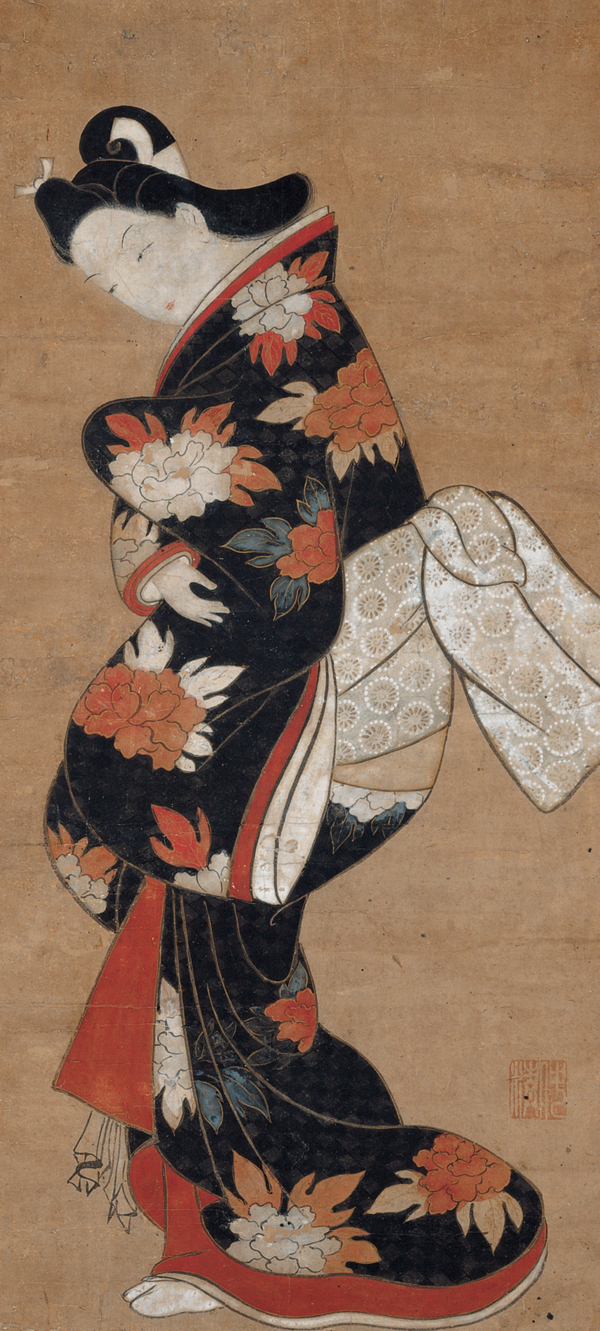Torii Kiyonobu I on:
[Wikipedia]
[Google]
[Amazon]
 Torii Kiyonobu I ( ja, 鳥居 清信; – 22 August 1729) was a Japanese painter and printmaker in the
Torii Kiyonobu I ( ja, 鳥居 清信; – 22 August 1729) was a Japanese painter and printmaker in the
 Torii Kiyonobu I ( ja, 鳥居 清信; – 22 August 1729) was a Japanese painter and printmaker in the
Torii Kiyonobu I ( ja, 鳥居 清信; – 22 August 1729) was a Japanese painter and printmaker in the ukiyo-e
Ukiyo-e is a genre of Japanese art which flourished from the 17th through 19th centuries. Its artists produced woodblock prints and paintings of such subjects as female beauties; kabuki actors and sumo wrestlers; scenes from history and folk t ...
style, who is renowned for his work on kabuki
is a classical form of Japanese dance- drama. Kabuki theatre is known for its heavily-stylised performances, the often-glamorous costumes worn by performers, and for the elaborate make-up worn by some of its performers.
Kabuki is though ...
signboards and related materials. Along with his father Torii Kiyomoto
Torii Kiyomoto ( ja, 鳥居 清元; 1645–1702) was a kabuki actor from Osaka and painter of billboards and other kabuki advertisements; the founder of the Torii school of artists, he painted in an early form of what came to be known as the ukiyo ...
, he is said to have been one of the founders of the Torii school
A is a traditional Japanese gate most commonly found at the entrance of or within a Shinto shrine, where it symbolically marks the transition from the mundane to the sacred.
The presence of a ''torii'' at the entrance is usually the simplest ...
of painting.
Known in childhood as Shōbei, young Kiyonobu was the second son of the established Osaka
is a designated city in the Kansai region of Honshu in Japan. It is the capital of and most populous city in Osaka Prefecture, and the third most populous city in Japan, following Special wards of Tokyo and Yokohama. With a population of ...
kabuki actor and painter Torii Kiyomoto, born in 1664. He moved, with his father, to Edo (modern Tokyo) when he was twenty-four, and emerged there as a major artist with a unique style. Kiyonobu's work is regarded as being highly influenced by that of Hishikawa Moronobu
Hishikawa Moronobu ( ja, 菱川 師宣; 1618 – 25 July 1694) was a Japanese artist known for popularizing the ukiyo-e genre of woodblock prints and paintings in the late 17th century. He consolidated the works of scattered Japanese art s ...
(d. 1694), the father of ukiyo-e; Kiyonobu would also have been well-versed, as most major artists were at the time, in the styles of the Kanō and Tosa school
of Japanese painting was founded in the early Muromachi period (14th–15th centuries),,p.988 and was devoted to ''yamato-e'', paintings specializing in subject matter and techniques derived from ancient Japanese art, as opposed to schools influe ...
s.
Kiyonobu focused almost exclusively on producing billboards and other promotional material for Edo's kabuki theaters; the relationship between the theaters and the Torii school was a strong and important one, and one that continues today. Guided by the need to attract attention, Kiyonobu's style tended towards bold, colorful exuberance. In addition to a distinctive use of color, details, and various other aesthetic elements, the Torii style is especially distinguished by the use of thick, bold line.
By 1700, Kiyonobu was a fully established and accomplished artist. His works were praised by contemporary writers, and were often even placed in Shintō
Shinto () is a religion from Japan. Classified as an East Asian religion by scholars of religion, its practitioners often regard it as Japan's indigenous religion and as a nature religion. Scholars sometimes call its practitioners ''Shintoist ...
shrines as votive offerings, a fact which indicates something of the artistic quality or emotional impact of his depictions of Kabuki actors. By the time of his death in 1729, Kiyonobu had not only painted a great number of signboards and the like, but had also produced illustrations for woodblock printed books, depicting kabuki dramas, and had issued individual prints as well.
As is the case with most Torii school artists, Kiyonobu's dates are not known for sure, and the relationships between the various Torii artists are similarly unclear. The styles of Kiyonobu's disciples and relatives are very similar, and most scholars entertain the possibility that Kiyonobu II or Kiyomasu I were the same man as the subject of this article, Kiyonobu I, or as one another. Very few, if any, paintings created by the Torii school are known definitely to have been painted by any one particular artist.
See also
*Torii Kiyonobu II
Torii Kiyonobu II ( ja, 二代目 鳥居 清信 ''Nidaime Torii Kiyonobu''; active 1725–1760) was a Japanese ukiyo-e artist. He headed the Torii artistic school from possibly as early as 1725, when its founder Torii Kiyonobu I reti ...
– Kiyonobu's successor as head of the Torii school, and likely his son
*Torii Kiyomasu
was a Japanese painter and printmaker of the Torii school, in the genre of ''ukiyo-e''. Like the other Torii artists, his primary focus was on Kabuki billboards, advertisements, actor prints, and other related material. Many scholars believe Kiy ...
– a contemporary of Kiyonobu, in a somewhat different style. Kiyomasu may have been Kiyonobu's brother, or they may have even been the same man.
References
* Hickman, Money (1993). "Enduring Alliance: The Torii Line of Ukiyo-e Artists and Their Work for the Kabuki Theatre." ''Fenway Court'', 1992. Boston: Isabella Stewart Gardner Museum. *Carter, Thomas Frances. ''The Invention of Printing in China and its spread Westward'' 2nd ed., revised by L. Carrington Goodrich. NY:Ronald Press, 19355. (1st ed, 1925)External links
{{DEFAULTSORT:Torii, Kiyonobu 01 Ukiyo-e artists 1660s births 1729 deaths 17th-century Japanese artists 18th-century Japanese artists Torii school